Wistron EM300 Wistron EM300 User Manual EM300 Module integration guide1
Wistron Corporation Wistron EM300 EM300 Module integration guide1
Wistron >
Users Manual
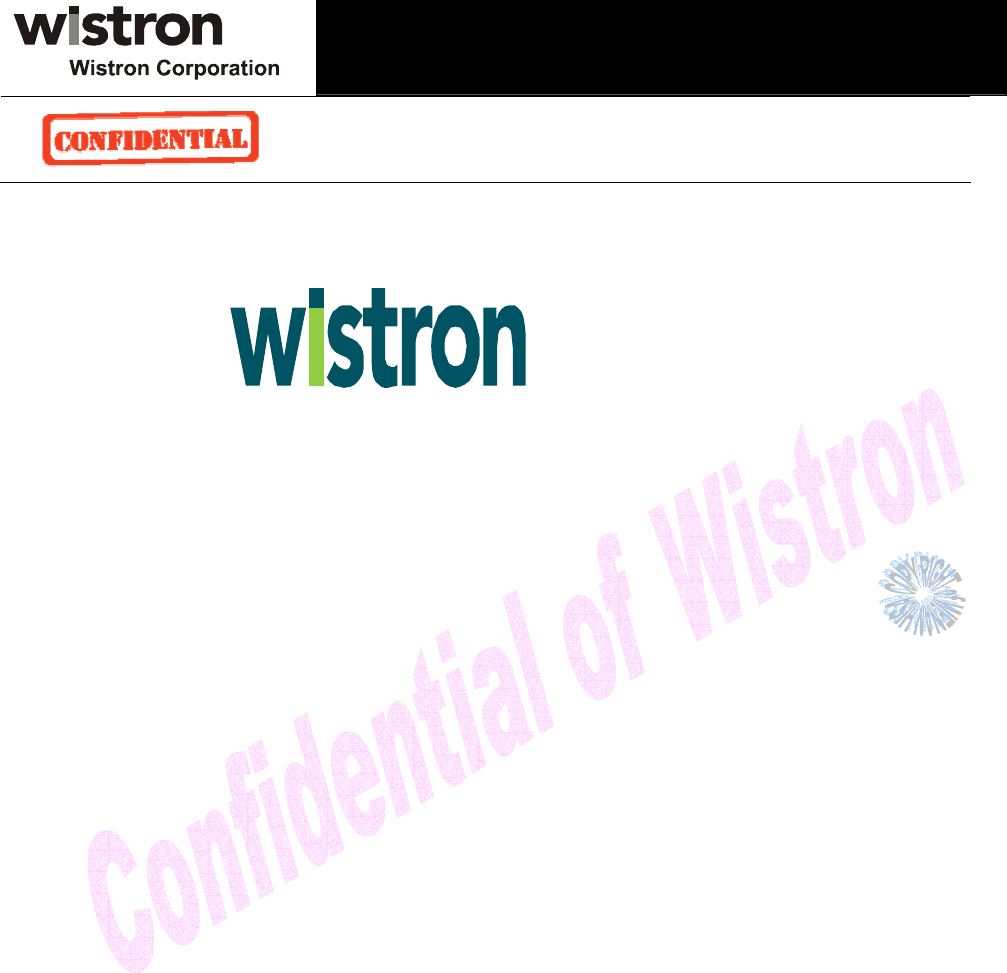
EM300 Data Card Integration Guide
R&D Division, Handheld & Mobile Communication,
Taipei Design Center, Wistron Corp.
Engineering Specification
1
EM300 Module
Module/Data Card integration guide
Ver: 1.0
2008/12/01
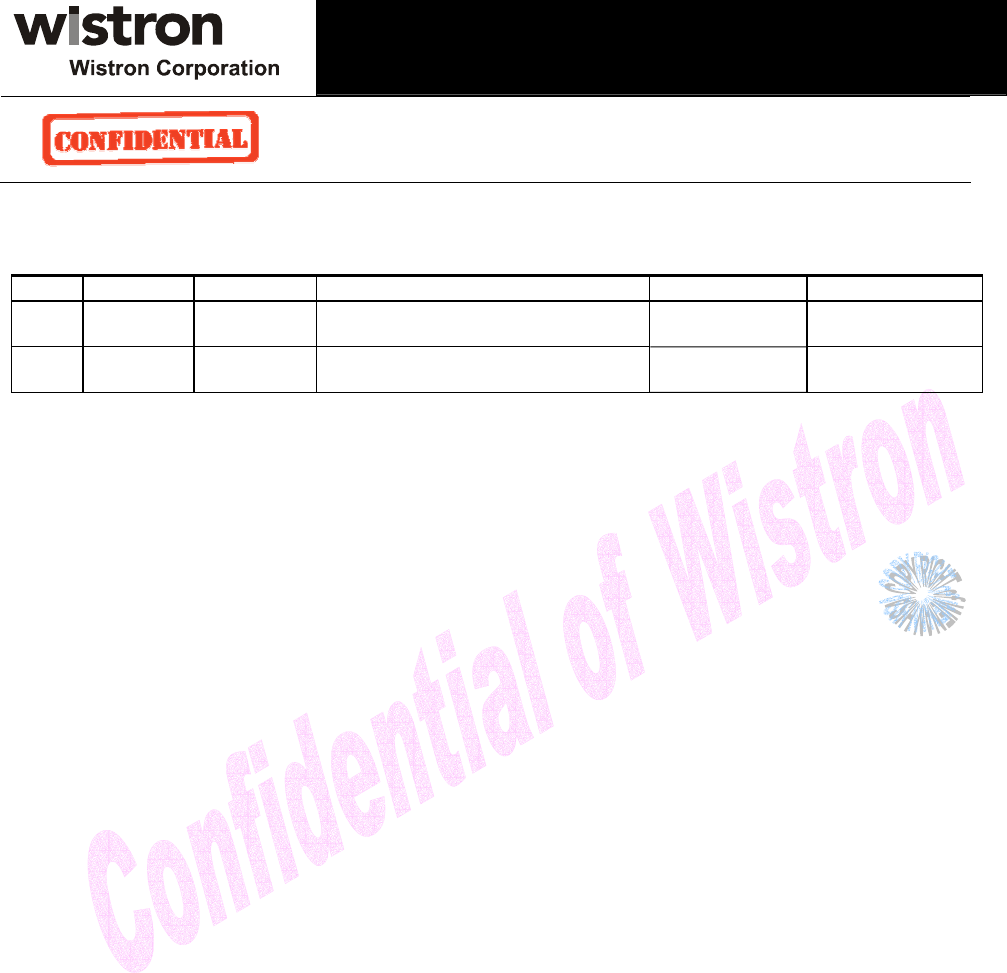
EM300 Data Card Integration Guide
R&D Division, Handheld & Mobile Communication,
Taipei Design Center, Wistron Corp.
Engineering Specification
1
Document Revision History
Rev. ECO # Date Brief Description of Change Originator Approved by
Draft Nov 25
th
2008
Initial release of Draft Version for
Customer Review and Feedback
Richard Hsieh
Check Dec 1
s
t
2008
Check and Review Brian Yang
Notice: Restricted Proprietary Information and subject to the confidentiality restrictions contained
in any applicable non-disclosure agreement.
The information contained in this document is the exclusive property of Wistron Coporation, Inc.
All rights reserved. Unauthorized reproduction of this manual in any form without the expressed
written approval of Wistron Wireless, Inc. is strictly prohibited. This manual may not, in whole or in
part, be copied, reproduced, translated, or reduced to any electronic or magnetic storage medium
without the written consent of a duly authorized officer of Wistron Wireless, Inc.
The information contained in this document is subject to change without notice and should not be
construed as a commitment by Wistron Wireless, Inc. unless such commitment is expressly given
in a covering document.
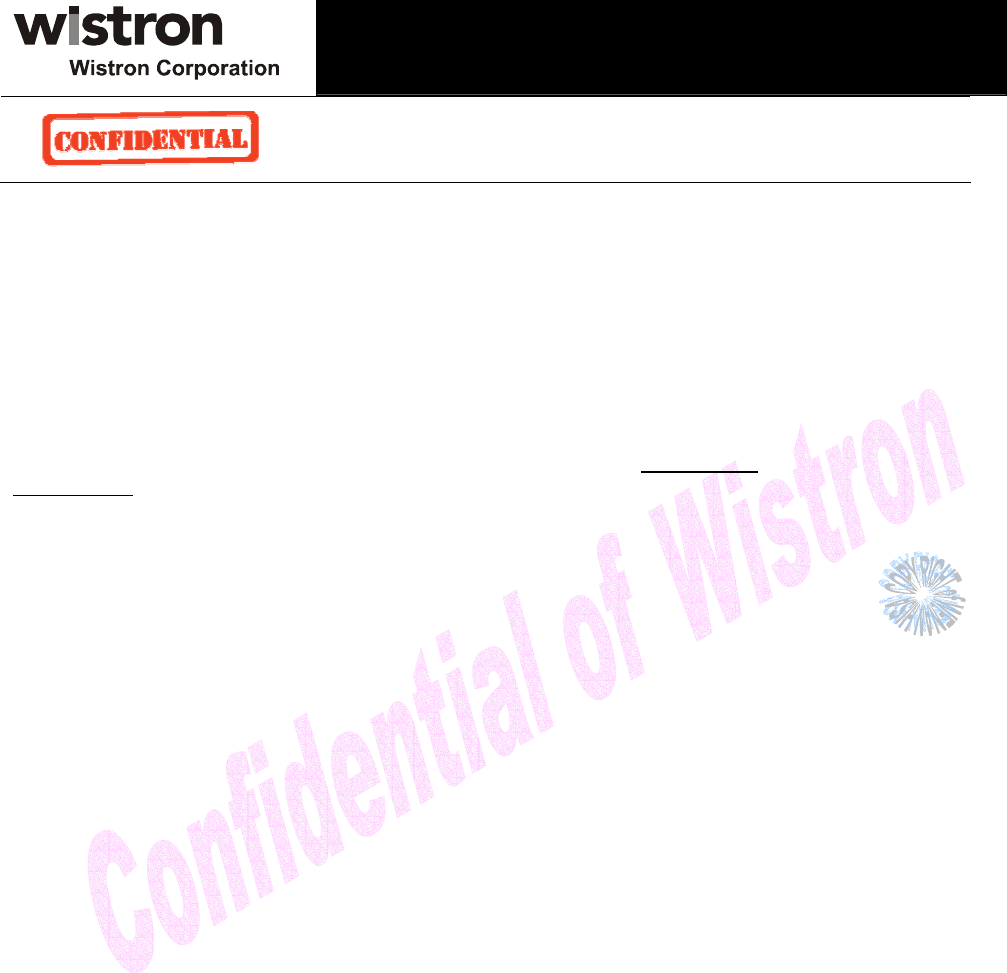
EM300 Data Card Integration Guide
R&D Division, Handheld & Mobile Communication,
Taipei Design Center, Wistron Corp.
Engineering Specification
2
Wistron Coporation, Inc. makes no warranties, either expressed or implied, regarding this
document, its merchantability, or its fitness, for any particular purpose.
Legal Disclaimer
This document and the information contained in the EM300 module& Design Guide
(together, the “Information”) is provided to you by Wistron Corporationfor informational
purposes only.
Wistron Corporationis providing the Information because Wistron Corporation believes the
Integration and Design Guidelines may be useful. The Information is provided on the condition
that you will
be responsible for making your own assessments of the information and are advised to verify all
representations, statements and information before using or relying upon any of the Information.
Although Wistron Corporationbelieves it has exercised reasonable care in providing the
Information, Wistron Corporationdoes not warrant the accuracy of the Information and is not
responsible for any damages arising from its use or reliance upon the Information. You further
understand and agree that Wistron Corporationin no way represents, and you in no way rely on
a belief, that Wistron
Corporationis providing the information in accordance with any standard or service (routine,
customary or otherwise) related to the consulting, services, hardware or software industries.
WISTRON CORPORATIONDOES NOT WARRANT THAT THE INFORMATION IS ERROR-
FREE. WISTRON CORPORATIONIS PROVIDING THE INFORMATION TO YOU "AS IS"
AND "WITH ALL FAULTS." WISTRON CORPORATIONDOES NOT WARRANT, BY VIRTUE
OF THIS DOCUMENT, OR BY ANY COURSE OF PERFORMANCE, COURSE OF DEALING,
USAGE OF TRADE OR
ANY COLLATERAL DOCUMENT HEREUNDER OR OTHERWISE, AND HEREBY EXPRESSLY
DISCLAIMS, ANY REPRESENTATION OR WARRANTY OF ANY KIND WITH RESPECT TO
THE INFORMATION, INCLUDING, WITHOUT LIMITATION, ANY REPRESENTATION OR
WARRANTY OF DESIGN, PERFORMANCE, MERCHANTABILITY, FITNESS FOR A
PARTICULAR PURPOSE OR NON-INFRINGEMENT, OR ANY REPRESENTATION OR
WARRANTY THAT THE INFORMATION IS APPLICABLE TO OR INTEROPERABLE WITH ANY
SYSTEM, DATA, HARDWARE OR SOFTWARE OF ANY KIND.
WISTRON CORPORATIONDISCLAIMS AND IN NO EVENT SHALL BE LIABLE FOR ANY
LOSSES OR DAMAGES OF ANY KIND, WHETHER DIRECT, INDIRECT, INCIDENTAL,
CONSEQUENTIAL, PUNITIVE, SPECIAL OR EXEMPLARY, INCLUDING, WITHOUT
LIMITATION, DAMAGES FOR LOSS OF BUSINESS PROFITS, BUSINESS INTERRUPTION,
LOSS OF BUSINESS INFORMATION, LOSS OF GOODWILL, COVER, TORTIOUS CONDUCT
OR OTHER PECUNIARY LOSS, ARISING OUT OF OR IN ANY WAY RELATED TO THE
PROVISION, NON-PROVISION, USE OR NON-USE OF THE INFORMATION, EVEN IF YOU
HAVE BEEN ADVISED OF THE POSSIBILITY OF SUCH LOSSES OR DAMAGES.
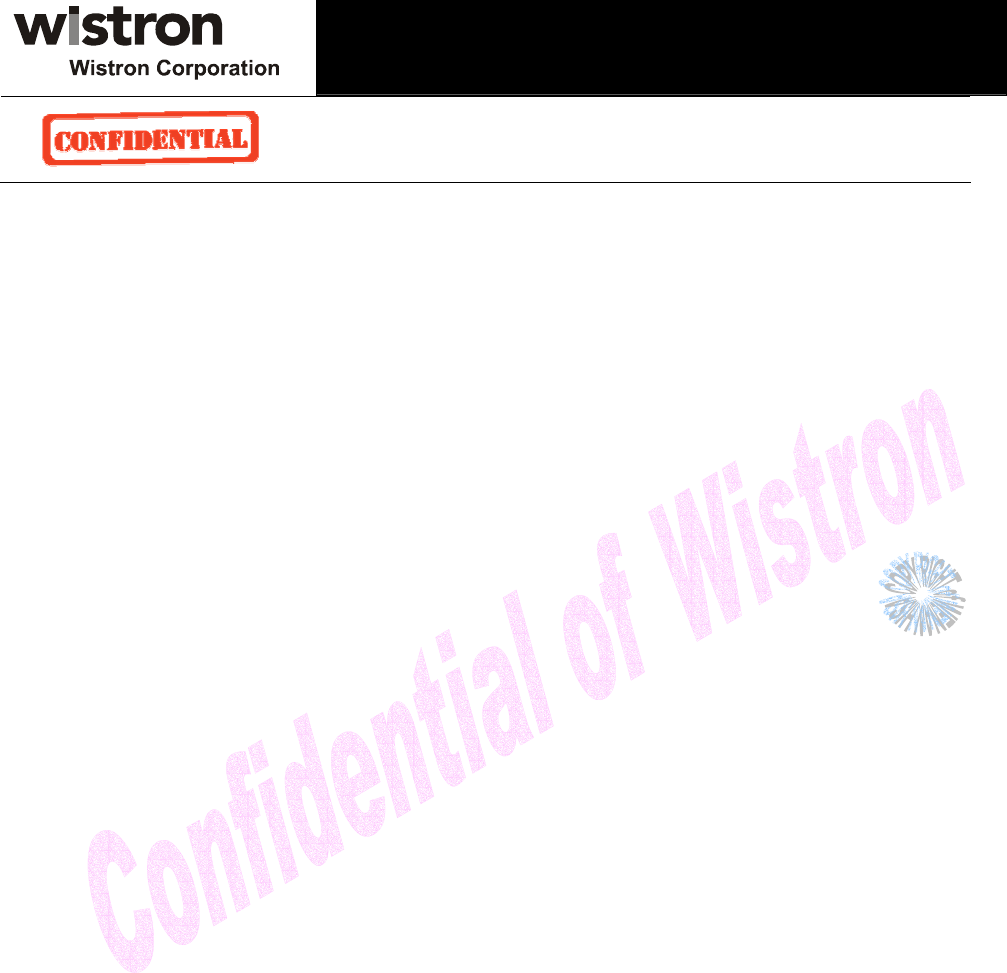
EM300 Data Card Integration Guide
R&D Division, Handheld & Mobile Communication,
Taipei Design Center, Wistron Corp.
Engineering Specification
3
Table of Contents
Reference Documents...................................................................................................................5
EM300 module.................................................................................................................5
3GPP References ........................................................................................................... 5
Safety Warning ................................................................................................................ 7
Federal Communications Commission Notice (FCC—United States) ............................. 8
Radio Frequency Exposure Evaluation Requirements ................................................. …8
Compliance & Certification Requirements ..................................................................... 11
Getting Started............................................................................................................................. 12
Feature List ………………………………………………………………………………........13
General.......................................................................................................................... 18
Setting Up...................................................................................................................... 20

EM300 Data Card Integration Guide
R&D Division, Handheld & Mobile Communication,
Taipei Design Center, Wistron Corp.
Engineering Specification
4
Operation is subject to the following two conditions: (1) this device may not cause interference,
and (2) this device must accept any interference, including interference that may cause undesired
operation of the device.
The OEM integrator has to be aware not to provide information to the end user regarding how to install or
remove this RF module in the user manual of the end product.
The user manual which is provided by OEM integrators for end user must include the following the
Information in a prominent location.
"TO comply with FCC RF exposure compliance requirements, the antenna use for this transmitter must be
in
sta
ll
ed
to
p
r
o
vi
de
a
sepa
r
at
i
o
n
d
i
sta
n
ce
o
f
at
l
east
2
0c
m fr
o
m
a
ll
pe
r
so
n
s
a
n
d
m
ust
n
ot
be
co
-l
ocated
o
r
o
p
eratin
g
in con
j
unction with an
y
other antenna transmitter.
Frequency range, the warning statement in the user manual of the end product should include the
r
est
ri
ct
i
o
n
o
f
ope
r
at
in
g
t
hi
s
de
vi
ce
in in
doo
r
cou
l
d
v
o
i
d
t
h
e
use
r
s
aut
h
o
ri
ty
to
ope
r
ate
t
h
e
equ
i
p
m
e
n
t
.’’
Lable for end
p
roduct must include ‘‘Contains FCC ID:PU5-EM300’’or ‘‘A RF transmitter inside’ FCC
ID :PU5
-
EM300
’’
.
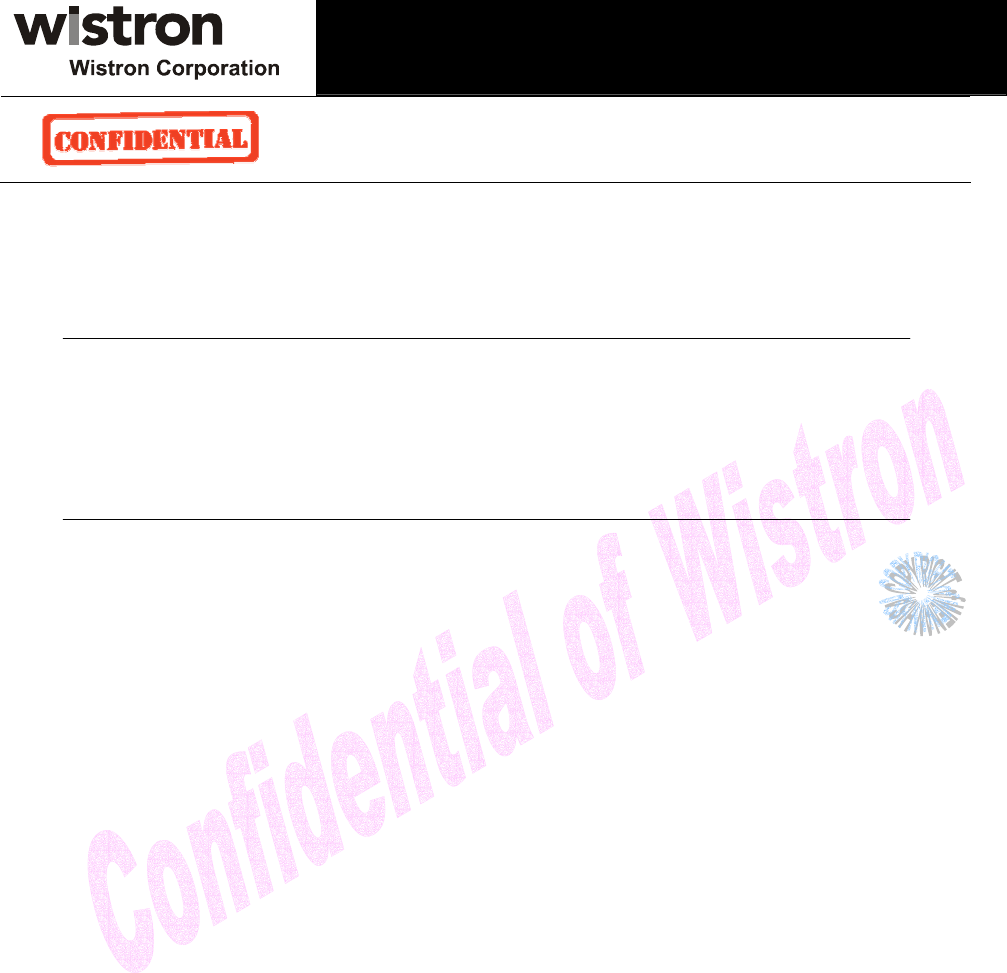
EM300 Data Card Integration Guide
R&D Division, Handheld & Mobile Communication,
Taipei Design Center, Wistron Corp.
Engineering Specification
5
Reference Documents
Phone module
EM300 module Electromehcanical Specification Revision 1.0June 25, 2008
EM300 HW specification Version 1.1 June 25, 2008
3GPP References
The following documents contain provisions which, through reference in this text, constitute provisions of the
present document.
References are either specific (identified by date of publication, edition number, version number, etc.)
or non-specific.
For a specific reference, subsequent revisions do not apply.
For a non-specific reference, the latest version applies. In the case of a reference to a 3GPP document
(including a GSM document), a non-specific reference implicitly refers to the latest version of that
document in the same Release as the present document.
[1] Void.
[2] 3GPP TS 23.038: "Alphabets and language-specific information".
[3] 3GPP TS 23.040: "Technical realization of the Short Message Service (SMS) ".
[4] 3GPP TS 23.041: "Technical realization of the Cell Broadcast Service (CBS)".
[5] 3GPP TS 24.008: "Mobile Radio Interface Layer 3 specification; Core Network
Protocols; Stage 3".
[6] 3GPP TS 24.011: "Short Message Service (SMS) support on mobile radio interface".
[7] 3GPP TS 24.012: "Cell Broadcast Service (CBS) support on the mobile radio interface".
[8] 3GPP TS 27.001: "General on Terminal Adaptation Functions (TAF) for Mobile
Stations (MS)".
[9] 3GPP TS 27.007: "AT command set for User Equipment (UE)".
[10] 3GPP TS 51.011: "Specification of the Subscriber Identity Module - Mobile
Equipment (SIM - ME) interface".
[11] ITU-T Recommendation V.25ter: "Serial asynchronous automatic dialing and control".
[12] ITU-T Recommendation V.24: "List of definitions for interchange circuits between data terminal
equipment (DTE) and data circuit-terminating equipment (DCE)".
[13] ITU-T Recommendation E.164: "The international public telecommunication numbering
plan".
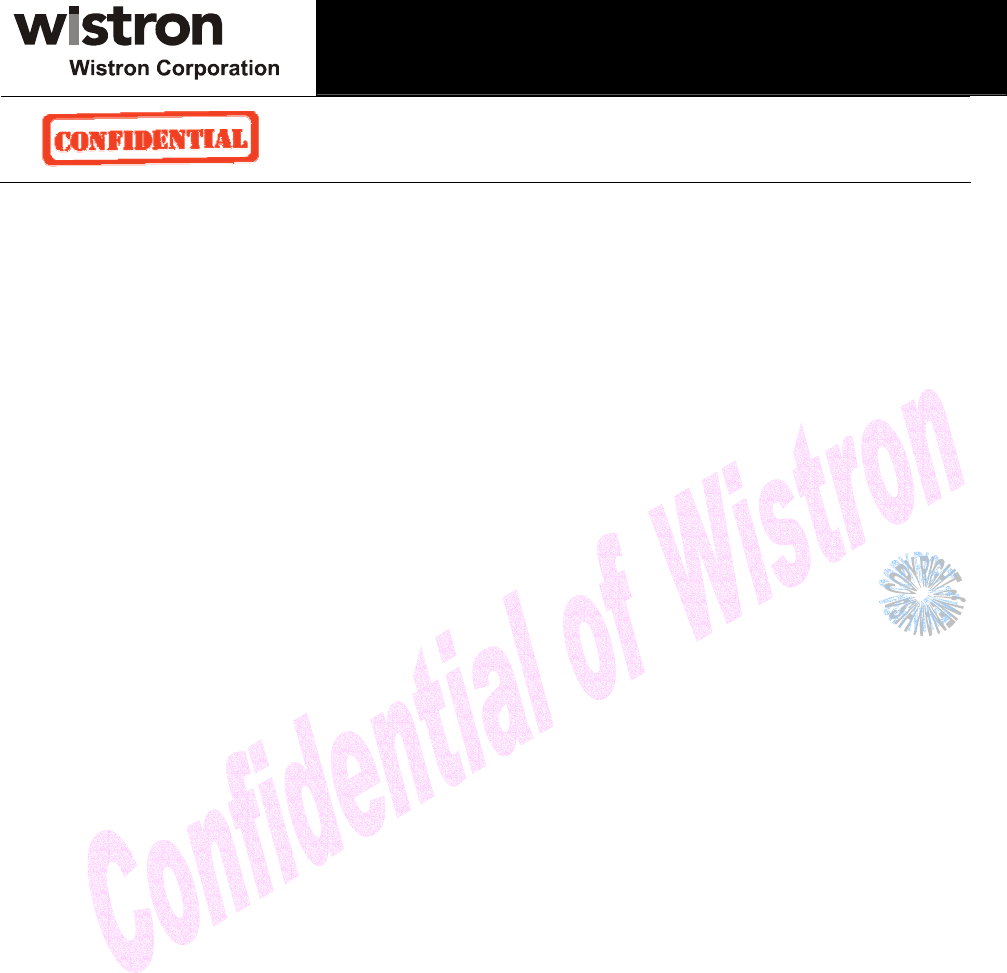
EM300 Data Card Integration Guide
R&D Division, Handheld & Mobile Communication,
Taipei Design Center, Wistron Corp.
Engineering Specification
6
[14] ITU-T Recommendation E.163: "Numbering plan for the international telephone
service".
[15] 3GPP TR 21.905: "Vocabulary for 3GPP Specifications".
[16] 3GPP TS 31.102: "Characteristics of the USIM application.
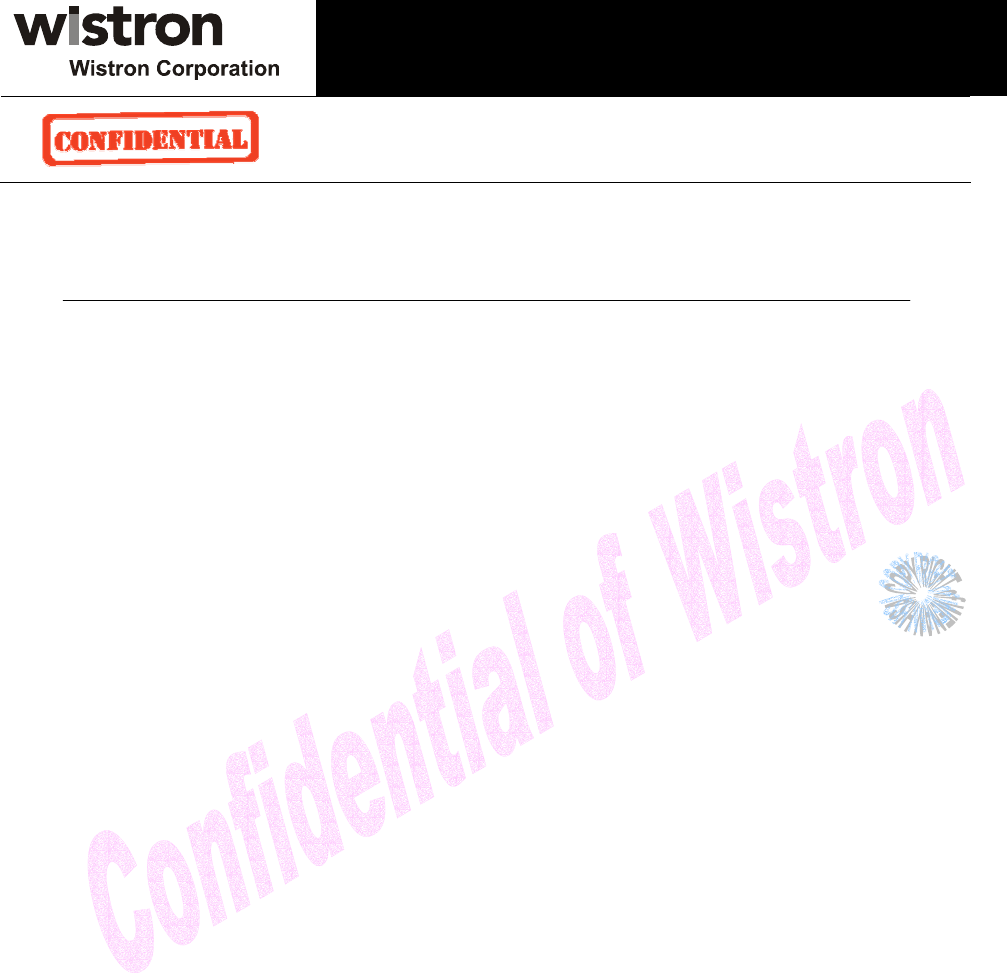
EM300 Data Card Integration Guide
R&D Division, Handheld & Mobile Communication,
Taipei Design Center, Wistron Corp.
Engineering Specification
7
Notices
Safety Warning
Neither the nor EM300 MODULE / Data Card products may be used in an environment where radio
frequency equipment is prohibited or restricted in its use. This includes aircraft/airports, hospitals, and
other sensitive electronic areas.
Do not operate RF devices in an environment that may be susceptible to radio interference
resulting in danger, specifically:
xAreas where prohibited by the law
Follow any special rules and regulations and obey all signs and notices. Always
turn off the host device when instructed to do so, or when you suspect that it may cause
interference or danger.
xWhere explosive atmospheres may be present
Do not operate your modem in any area where a potentially explosive
atmosphere may exist. Sparks in such areas could cause an explosion or fire resulting
in bodily injury or even death. Be aware and comply with all signs and instructions.
xUsers are advised not to operate the modem while at a refueling point or service station.
Users are reminded to observe restrictions on the use of radio equipment in fuel depots
(fuel storage and distribution areas), chemical plants or where blasting
operations are in progress.
xAreas with a potentially explosive atmosphere are often but not always clearly marked.
Potential locations can include gas stations, below deck on boats, chemical
transfer or storage facilities, vehicles using liquefied petroleum gas (such as propane or
butane), areas where the air contains chemicals or particles, such as grain, dust or metal
powders, and any other area where you would normally be advised to turn off your
vehicle engine.
xNear Medical and life support equipment
Do not operate your modem in any area where medical equipment, or life support
equipment may be located, or near any equipment that may be susceptible to
any form of radio interference. In such areas, the host communications device
must be turned off. The modem may transmit signals that could interfere with this
equipment.
xOn an aircraft, either on the ground or airborne
In addition to FAA requirements, many airline regulations state that you must
suspend Corporationoperations before boarding an airplane. Please ensure that the host
device is turned off and your modem is removed from the card slot prior to boarding
aircraft in order to comply with these regulations. The modem can transmit signals that
could interfere with various onboard systems and controls.
xWhile operating a vehicle
The driver or operator of any vehicle should not operate a Corporationdata device.
Doing so will detract from the driver or operator's control and operation of that
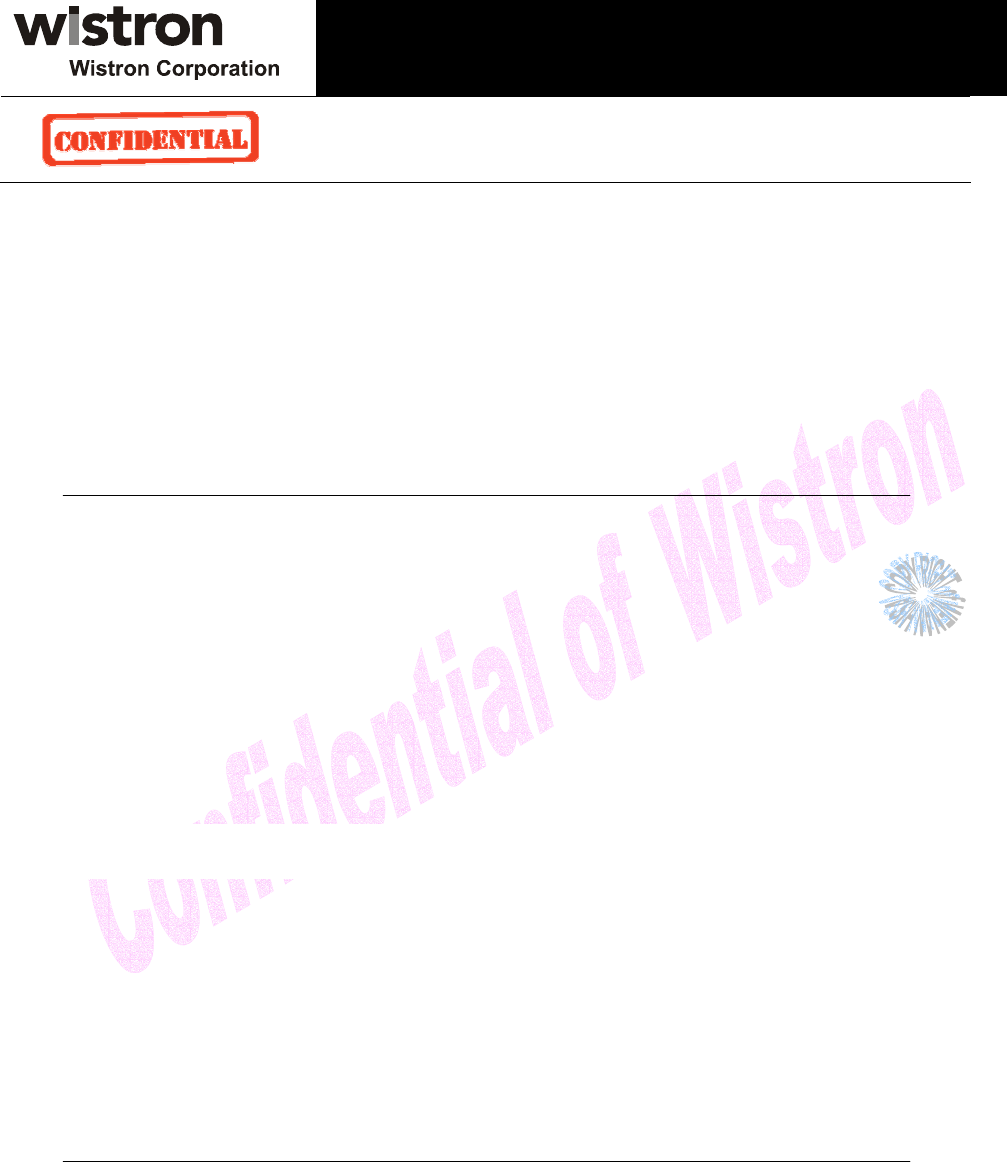
EM300 Data Card Integration Guide
R&D Division, Handheld & Mobile Communication,
Taipei Design Center, Wistron Corp.
Engineering Specification
8
vehicle. In some countries, operating such communication devices while in control of a vehicle is an
offence.
Under extended operation the and EM300 MODULE modem will generate a noticeable amount of heat.
Like all PC Cards, the modem generates heat during normal operation and will be heated
by the host computer. For this reason it is recommended that after extended periods of operation, prior to
removal and handling, you allow the modem to cool down.
Federal Communications Commission Notice (FCC—United States)
This equipment has been tested and found to comply with the limits for a class B digital device, pursuant to
part 15 of the FCC rules. These limits are designed to provide to provide reasonable protection against
harmful interference in a residential installation. This equipment generates, uses and can radiate radio
frequency energy and, if not installed and used in accordance with the installation. , May cause harmful
interference to radio communication. However, there is no guarantee that interference
Will not occur in a particular installation. if this equipment does cause harmful interference to radio or
television reception, which can be determined by turning the equipment off and on, the user is encouraged
to try to correct the interference by one or more of the following measures:
-Reorient or relocate the receiving antenna
-Increase the separation between the equipment and the receiver
-Connect the equipment into an outlet on a circuit different from that to which the receiver is connected
-Consult the dealer or an experienced radio/television technician for help
This device complies with Part 15 of the Federal Communications Commission (FCC) Rules.
Operation is subject to the following two conditions:
1. This device may not cause harmful interference.
2. This device must accept any interference received, including interference that may cause
undesired operation.
Radio Frequency Exposure Evaluation Requirements
This Corporationmodule is a radio transmitter and receiver. It is designed and manufactured not to
exceed the exposure limits for radio frequency (RF) energy set by the Federal Communications
Commission (FCC) of the U.S. Government. These limits are part of comprehensive guidelines and
establish permitted levels of RF energy for the general population. The guidelines are based
on standards that were developed by independent scientific organizations through periodic and thorough
evaluation of scientific studies. The standards include a substantial safety margin designed to assure
the safety of all persons, regardless of age and health.
You are cautioned that chan
g
es or modifications not ex
p
ressl
y
a
pp
roved b
y
the
p
art
y
res
p
onsible for com
p
liance could void
y
our authorit
y
to o
p
erate the e
q
ui
p
ment.
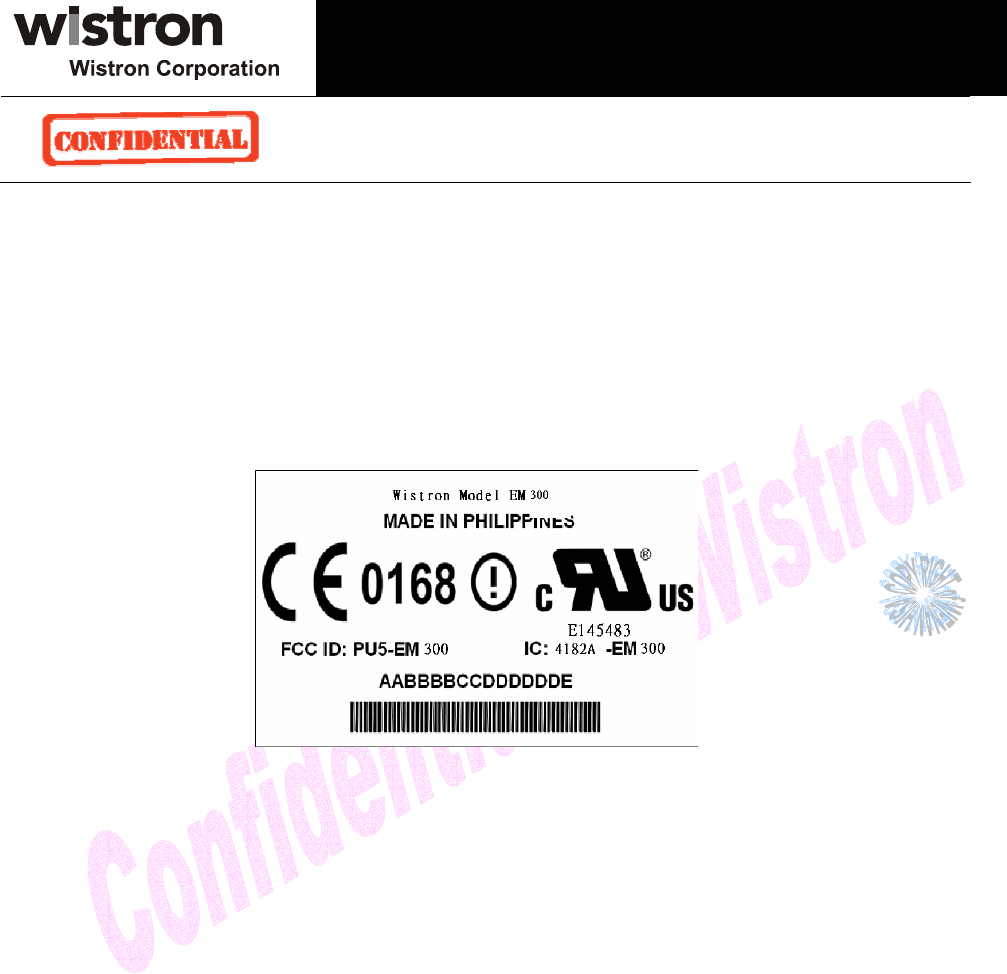
EM300 Data Card Integration Guide
R&D Division, Handheld & Mobile Communication,
Taipei Design Center, Wistron Corp.
Engineering Specification
9
The exposure standard for Corporationdevices including mobile phones and Corporationmodems uses
a unit of measurement known as the Specific Absorption Rate, or SAR. Tests for SAR are conducted
using standard operating positions reviewed by the FCC with the device under test.
This device is to be used only for mobile and fixed applications. The antenna installation and
operating configurations of this transmitter, including any applicable source-based time-averaging duty
factor, antenna gain and cable loss must satisfy MPE categorical Exclusion Requirements of
§2.1091. The antenna(s) used for this transmitter must be installed to provide a separation distance of
at least 20 cm from all persons and must not be co-located or operating in conjunction with any other
antenna or transmitter.
transmitting at its highest certified power level in all frequency bands. Although the SAR is
determined at the highest certified power level, the actual SAR level of the phone or modem while
operating can be well below the maximum value. This is because the phone or modem is
designed to operate at multiple power levels so as to use only the power required to reach the network.
In general, the closer you are to a Corporationbase station antenna, the lower the power
output.
Before this device is made available for sale to the public, it must be tested and certified to the
FCC that it does not exceed the limit established by the government-adopted requirement for safe
exposure. The tests are performed in positions and locations (for example, at the ear or worn on
the body) as required by the FCC for each model.
In general, for the United States market, the embedded modules are treated as “mobile devices”
as per FCC CFR47 paragraph 2.1091. A mobile device is defined as “a transmitting device designed to
be used in other than fixed locations and to generally be used in such a way that a separation distance
of at least 20 cm is normally maintained between the transmitter’s radiating structure(s) and the body of
the user or nearby persons.” Manufactures of mobile devices may
be able to submit a Maximum Exposure Rate (MPE) calculation in order to demonstrate SAR
compliance.
CE (Conformité Européenne or European Conformity)
This module will be tested to and conforms to the regulatory requirements of the European Union and
has attained CE Marking. The CE Mark is a conformity marking consisting of the letters "CE". The CE
Mark applies to products regulated by certain European health, safety and environmental protection
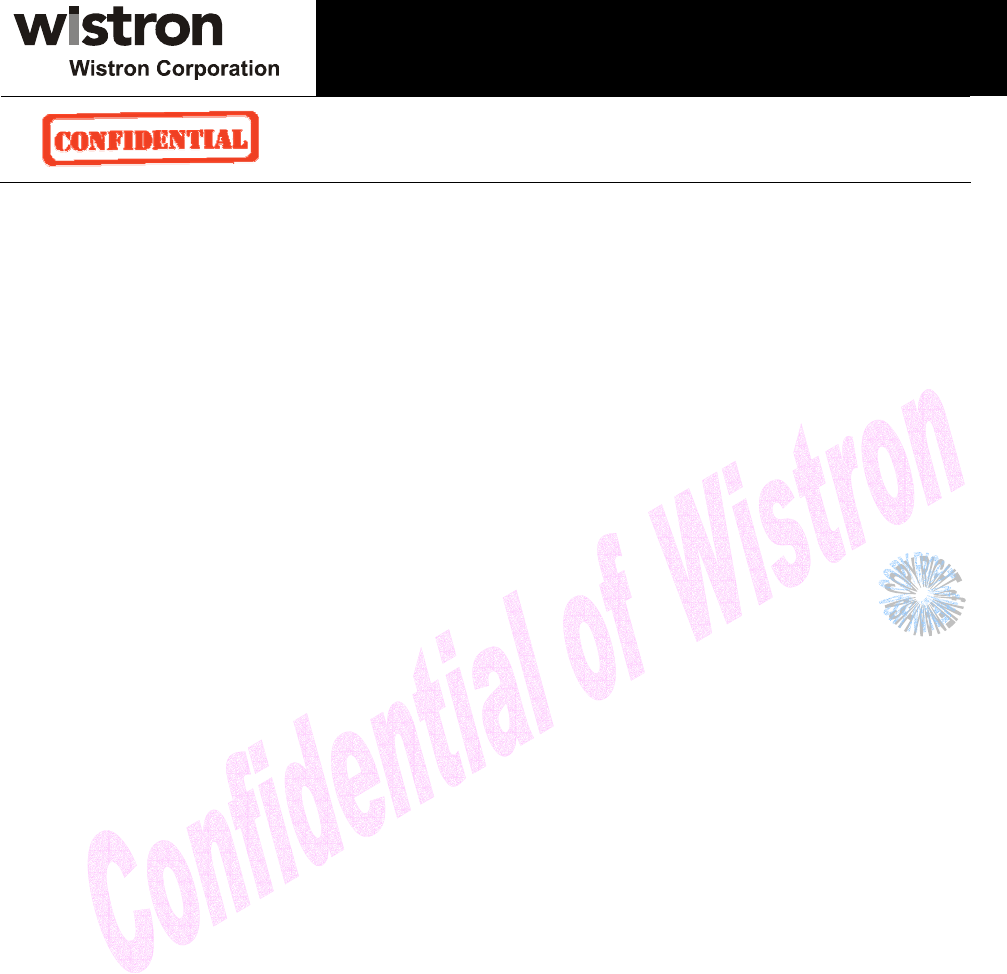
EM300 Data Card Integration Guide
R&D Division, Handheld & Mobile Communication,
Taipei Design Center, Wistron Corp.
Engineering Specification
10
legislation. The CE Mark is obligatory for products it applies to: the manufacturer
affixes the marking in order to be allowed to sell his product in the European market.
Radiocommunications and Telecommunications Terminal Equipment Industries (R&TTE)
This is mandatory for European operation and the directive applies to products using the radio
frequency spectrum and all equipment attached to public telecommunications networks.
This product conforms to the essential requirements of the Radiocommunications and
Telecommunications Terminal Equipment Directive (R&TTE) 1999/5/EC with respect to the
following articles:
x3.1a Safety
x3.1b EMC
x3.2 Spectrum
A notified body will determine that this device has properly demonstrated that the requirements of the
directive have been met and has issued a favorable certificate of expert opinion. As such the
device will bear the notified body number (TBD) after the CE Mark.
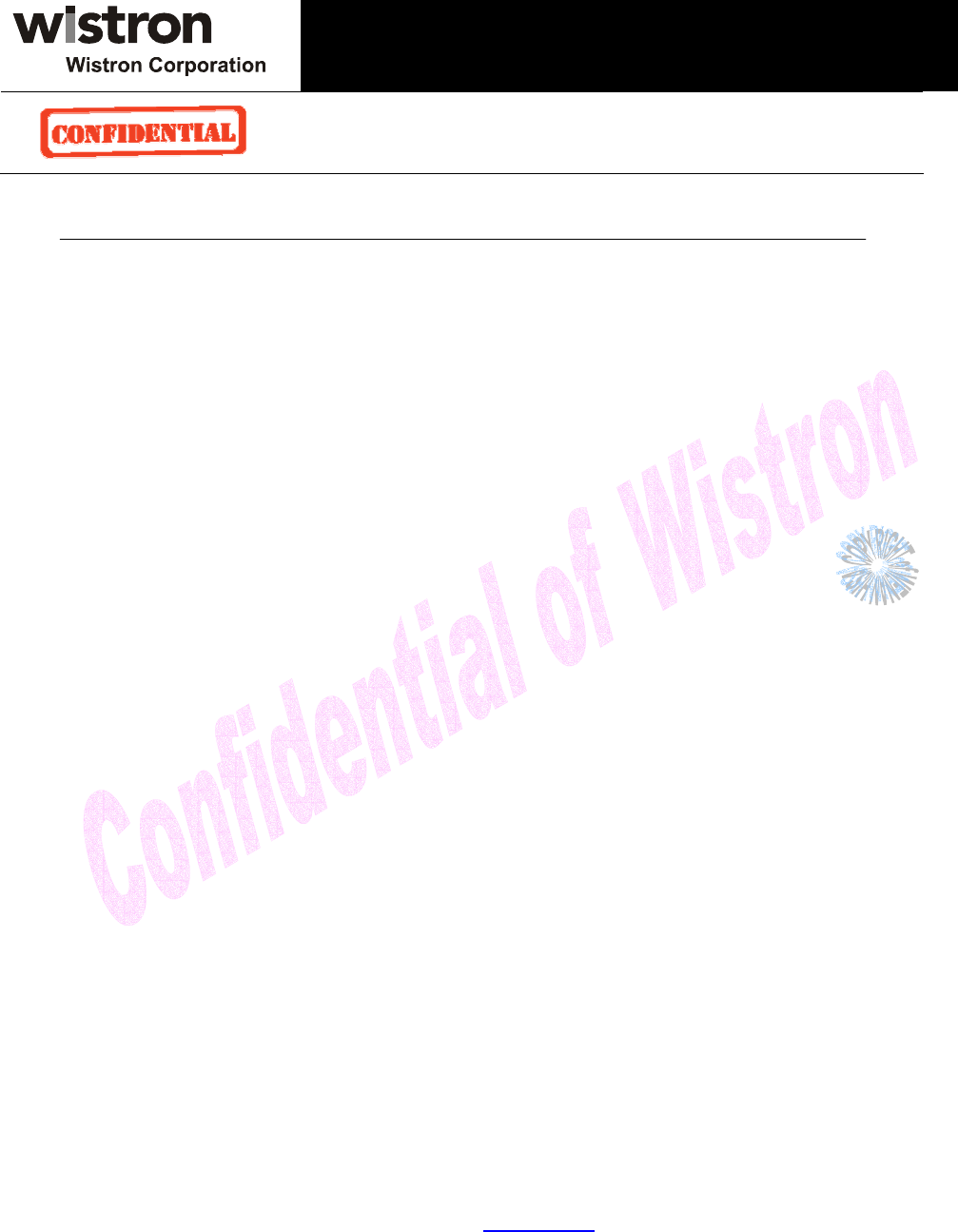
EM300 Data Card Integration Guide
R&D Division, Handheld & Mobile Communication,
Taipei Design Center, Wistron Corp.
Engineering Specification
11
Compliance & Certification Requirements
PCS Type Certification Review Board (PTCRB)
PTCRB Certification is mandated and the product is technically evaluated to meet the minimum requirements for
registration on the PTCRB Operators’ networks. The purpose of the PTCRB is to provide the framework within
which GSM Mobile Equipment (ME) Type Certification can take
place for members of the PTCRB. The PTCRB process is recommended for all Manufacturers
who wish to have their products operating within the areas served by the PTCRB Operators. This includes but is
not limited to determination of the test specifications and methods to implement
the Type Certification process for GSM Mobile Equipment.
PTCRB type certification will be based on GSM and OMA (Open Mobile Alliance) Specifications with
modifications per North American Standards and additional requirements from FCC rules, and any other
government agency that may have jurisdiction and or competence in the matter.
Additions to the PTCRB Specifications will be developed by the GSM operators. The additions will be limited
to MS-related features. The PTCRB document NAPRD 03 (Permanent Reference Document) will be modified
to include references to the above specifications once they are written and accepted by majority of the review
board.
To learn more about device certifications, please visit the PTCRB Website. You must sign up as a member to
gain access
Global Certification Forum (GCF),
The Global Certification Forum (GCF) is an independent organization with a wide-ranging membership of
operators, equipment manufacturers and other interested parties. The actions of the Forum are actively
supported by key staff from the Association Technical Projects operation and by the Association Executive
Management Committee.
GCF is recommended but not mandatory for attachment to the European network. It is a partnership
between network operators and terminal manufacturers and allows independent
interoperability validation of the 2G and 3G mobile Corporationterminal. GCF is typically required for formal
carrier technical acceptance of the mobile Corporationterminal.
Membership of GCF is entirely voluntary. Full GCF membership is open to mobile terminal manufacturers
and network operators. Other interested members of the mobile wireless
community, including test laboratories and test equipment manufacturers, may participate in GCF
as observers.
The current membership includes almost 150 network operators worldwide, more than 35 leading terminal
manufacturers and over 50 test equipment manufactures. Members decide the
organization and administration of the forum at regular Steering Group meetings. Technical issues
associated with testing new terminals and features are reviewed at regular Agreement Group meetings by
manufacturers, test laboratories and other observers.
To learn more about device certifications, please visit the GCF Website.The website identifies manufacture,
terminal names and the date which the terminal was certified. You must sign up as
A member to gain full access.
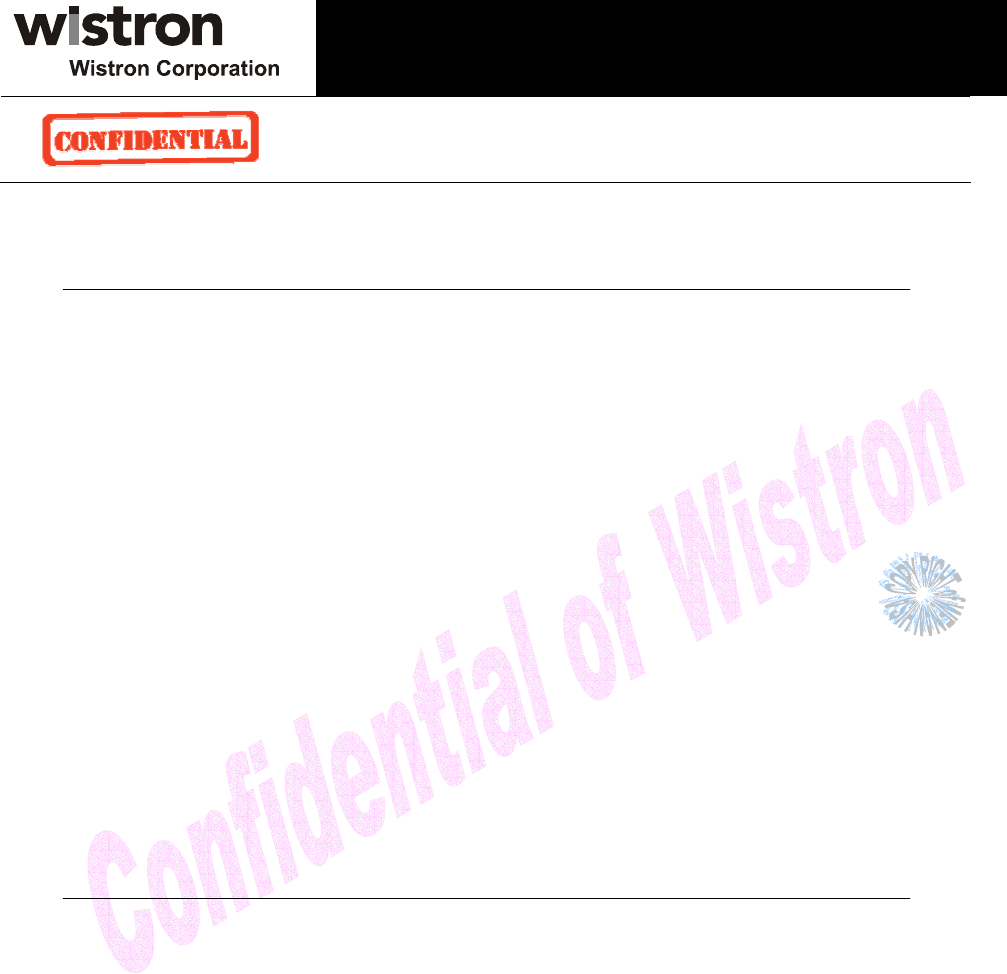
EM300 Data Card Integration Guide
R&D Division, Handheld & Mobile Communication,
Taipei Design Center, Wistron Corp.
Engineering Specification
12
Getting Started
General
The purpose of this document is to provide advance design and integration information to assist
in the integration planning and evaluation of Wistron CorporationUSB Cards. This document is intended to
specify key components of the integration tools available for the Wistron Corporationline of USB Cards.
The EM300 MODULE are Wistron Wireless’ versatile modules that add WWAN capability to other devices.
They were developed to be integrated into other devices based on the USB Card specification 1.2
The EM300 MODULE will work with all Windows driven laptops given the drivers are properly installed. When
MobiLink™ is installed on a Windows OS system it will automatically include the drivers necessary to
communicate with the USB Card. MobiLink™ is Wistron’s Windows application manager for the EM300
module. MobiLink provides an easy interface to make a data connection, change operating parameters, and
view alerts such as
SMS or signal strength indicator. However, anyone can still install the drivers manually. In addition, once the
drivers are installed, following the Wistron Client API functions, anyone could develop their Client side software
manager to interact with the USB Card.
When using any of these devices, EM300 MODULE, activation is required for the device to be allowed on the
operator’s network. For example, Sprint requires the customer to run IOTA (Internet Over-The-Air) provisioning
to prepare the device to work on the Corporationnetwork. Please refer to the Customer Configuration section on
provisioning with IOTA for assistance.
The EM300 MODULE and require a valid SIM card before it can be used on the operator’s
Corporationnetwork. Please refer to the Customer Configuration section on PRI for further information.
Setting Up
The purpose of this section is to assist in the initial connection and provide the reader with
instructions for how to setup and establish communication with the Wistron Corporationline of USB Card. The
following setup guide refers to an EM300 MODULE HSDPA Mini-card for convenience of
the set up discussion. The same setup is valid for both the EM300 MODULE EDGE and Mini-cards.
Setting up and establishing communication with the Wistron CorporationUSB Card involves:
oConnecting the USB Card to the computer and the Development Board.
oEstablishing communication with the USB Card and determining the
computer COM Port being used.
oSetting up and using the HyperTerminal program to communicate with the Mini-card
CONNECTING THE USB CARD TO THE COMPUTER AND THE DEVELOPMENT BOARD
Insert the USB Card into the Development Board (Wistron CorporationPart # 01017568)
by sliding the connector end of the Mini-card into the Molex connector. Push down on the opposite end
of the Mini-card until the 2 black locking tabs snap into place.

EM300 Data Card Integration Guide
R&D Division, Handheld & Mobile Communication,
Taipei Design Center, Wistron Corp.
Engineering Specification
13
EM300 MODULE EDGE Module Key Feature List
Feature Implementation
General
Frequency bands UMTS/HSDPA: Triple band, 850//1900/2100MHz
GSM/GPRS/EDGE: Quad band, 850/900/1800/1900MHz
GSM class Small MS
Output power
(according to Release
99, V6)
Class 4 (+33dBm ±2dB) for EGSM850
Class 4 (+33dBm ±2dB) for EGSM900
Class 1 (+30dBm ±2dB) for GSM1800
Class 1 (+30dBm ±2dB) for GSM1900
Class E2 (+27dBm ± 3dB) for GSM 850 8-PSK
Class E2 (+27dBm ± 3dB) for GSM 900 8-PSK
Class E2 (+26dBm +3 /-4dB) for GSM 1800 8-PSK
Class E2 (+26dBm +3 /-4dB) for GSM 1900 8-PSK
Class 3 (+24dBm +1/-3dB) for UMTS 2100, WCDMA FDD BdI
Class 3 (+24dBm +1/-3dB) for UMTS 1900,WCDMA FDD BdII
Class 3 (+24dBm +1/-3dB) for UMTS 850, WCDMA FDD BdV
Power supply 3.2V to 4.3V
Ambient operating
temperature according
to IEC 60068-2
Normal operation
-20°C to +70°C
Physical Stand Mini PCI-E
Weight: approx. 10g
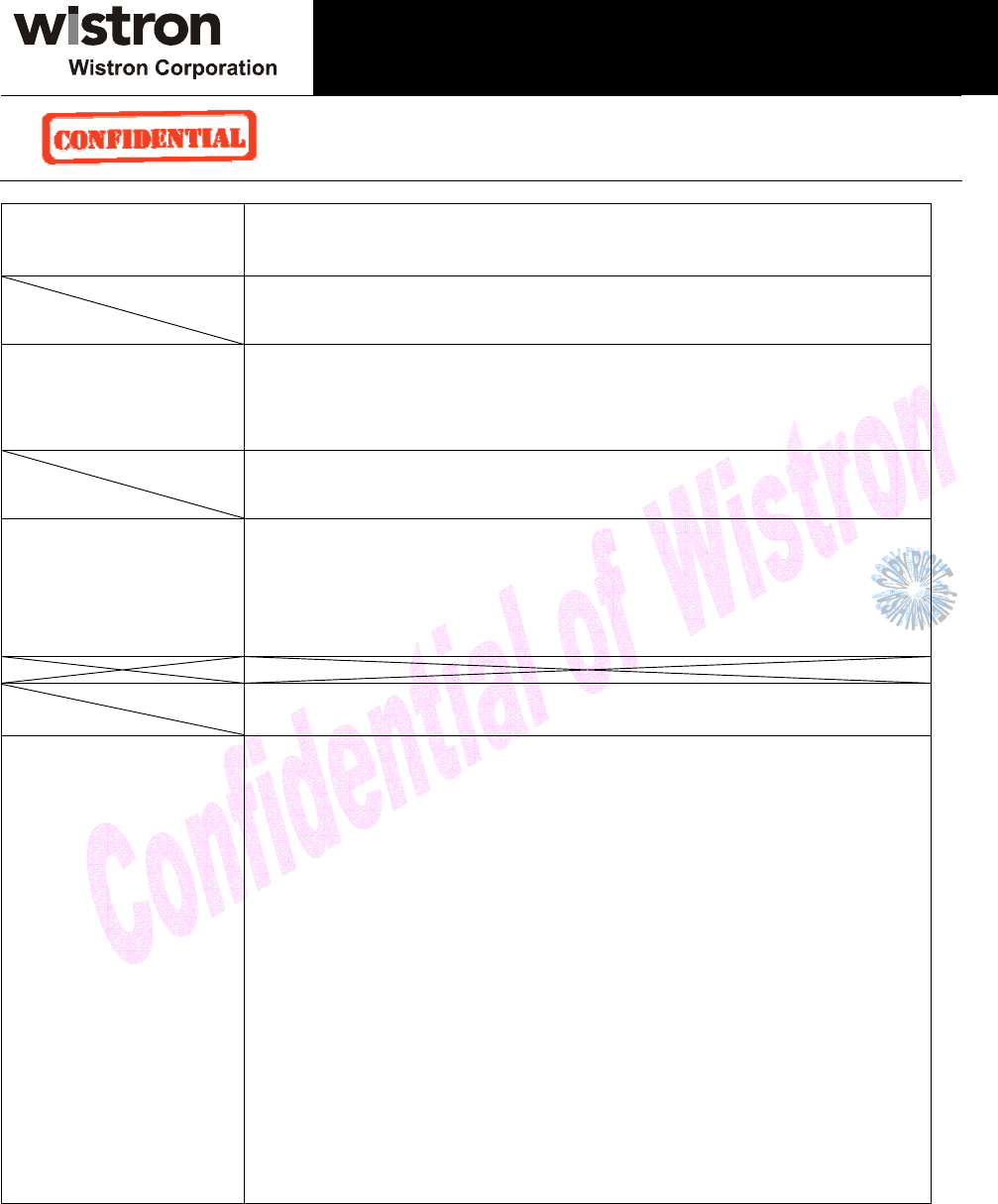
EM300 Data Card Integration Guide
R&D Division, Handheld & Mobile Communication,
Taipei Design Center, Wistron Corp.
Engineering Specification
14
RoHS All hardware components fully compliant with EU RoHS Directive
HSDPA features
3GPP Release 6 DL 7.2 Mbps, UL 384 kbps (HSDPA)
UE CAT. [1-8], 11, 12 supported
Compressed mode (CM) supported according to 3GPP TS25.212
UMTS features
Release 99, June 2004,
WCDMA
FDD standard
PS data rate – 384 kbps DL / 384 kbps UL
CS data rate – 64 kbps DL / 64 kbps UL
GSM / GPRS / EGPRS features
Data transfer GPRS
• Multislot Class 12
• Full PBCCH support
• Mobile Station Class B
• Coding Scheme 1 – 4
EGPRS
• Multislot Class 12
• EDGE E2 power class for 8 PSK
• Downlink coding schemes – CS 1-4, MCS 1-9
• Uplink coding schemes – CS 1-4, MCS 1-9
• BEP reporting
• SRB loopback and test mode B
• 8-bit, 11-bit RACH
• PBCCH support
• 1 phase/2 phase access procedures
• Link adaptation and IR
• NACC, extended UL TBF
• Mobile Station Class B
CSD
• V.110, RLP, non-transparent
• 9.6 kbps

EM300 Data Card Integration Guide
R&D Division, Handheld & Mobile Communication,
Taipei Design Center, Wistron Corp.
Engineering Specification
15
SMS (for pc default
non)
xPoint-to-point MT and MO
xCell broadcast
xText and PDU mode
xStorage: SIM card plus 25 SMS locations in mobile equipment
xTransmission of SMS alternatively over CSD or GPRS.
Preferred mode can be user defined.
Fax (default non) Group 3; Class 1
Audio (for pc default
non)
Audio speech codecs
GSM: AMR, EFR, FR, HR
3GPP: AMR
One ringing melody supported
CEPT supervisory tones supported
DTMF supported
6 audio modes: Approval, Router, Handset, Headset, Speakerphone and
Transparent mode
TTY support selecting a dedicated audio mode
Download of audio parameters
Gains and volumes can be controlled by AT commands
Several additional ringing melodies
CEPT and ANSI supervisory tones supported
Software
AT commands AT command
MicrosoftTM pc drive Windws 2000/XP/Vista 32/64 (INTEL & AMD)install drive
SIM Application Toolkit SAT Release 99
TCP/IP stack Access by AT commands
IP addresses IP version 6

EM300 Data Card Integration Guide
R&D Division, Handheld & Mobile Communication,
Taipei Design Center, Wistron Corp.
Engineering Specification
16
Remote SIM Access
By case (Standard
none support)
EM300 supports Remote SIM Access. RSA enables EM300 to
use
A remote SIM card via its serial interface and an external
application, in addition to the SIM card locally attached to the
dedicated lines of the application interface. The connection
between the external application and the remote SIM card can
be
a Bluetooth wireless link or a serial link.
The necessary protocols and procedures are implemented
according to the “SIM Access Profile Interoperability Specification
of the Bluetooth Special Interest Group” (SAP).
Firmware update Windows executable for update over serial interface and USB
port.
1 serial interfaces
1 USB interfaces
x8-wire modem interface with status and control lines,
unbalanced, asynchronous
xFixed bit rates: 300bps to 460,800bps
xAutobauding: 1,200bps to 460,800bps
xSupports RTS0/CTS0 hardware handshake and software
XON/XOFF flow control.
xMultiplex ability according to GSM 07.10
Interfaces
Audio (default non) x2 analog interfaces
SIM interface Supported SIM cards: 3V, 1.8V
SIM Application Toolkit SAT Class C
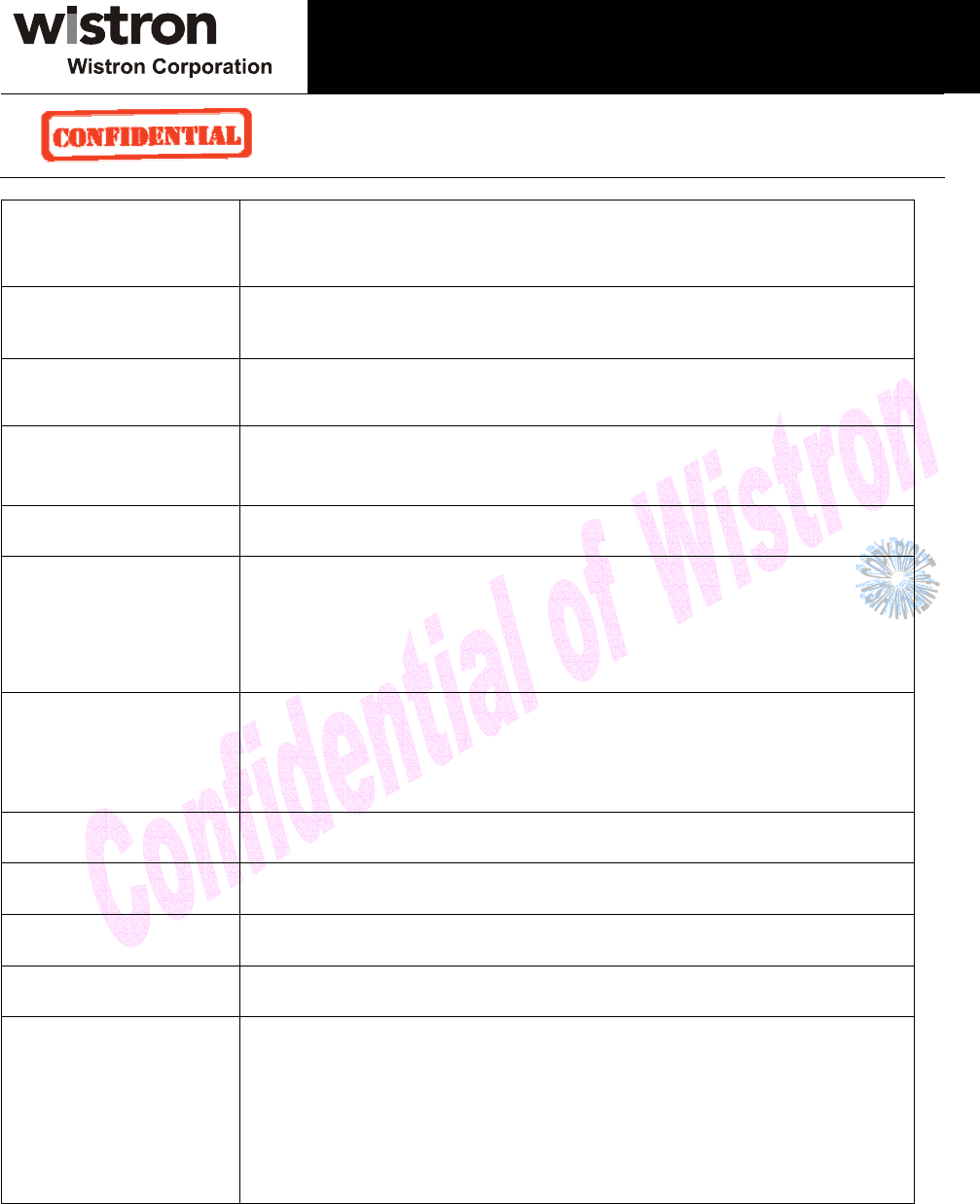
EM300 Data Card Integration Guide
R&D Division, Handheld & Mobile Communication,
Taipei Design Center, Wistron Corp.
Engineering Specification
17
Antenna 50Ohms. External antenna can be connected via antenna
connector or solderable pad (support diversity and non-diversity
default non diversity).
Module interface Stand Mini PCI-Express
USB Supports a USB 2.0 Full Speed (12Mbit/s) device interface.
Mini PCI Express
interface
NB standard Mini PCI Express (USB interface)
Power on/off, Reset
Power on/off xSwitch-on/off by hardware pin
xSwitch-off by AT command
Reset xEmergency off reset by hardware pins
Special features
Real time clock Timer functions via AT commands
Phonebook SIM and phone
Evaluation kit
EM300 evaluation
board
EM300 evaluation board Evaluation Board designed to test and
type approve Wistron cellular engines and provide a sample
configuration for application engineering.
ʳ
ʳ
ʳ
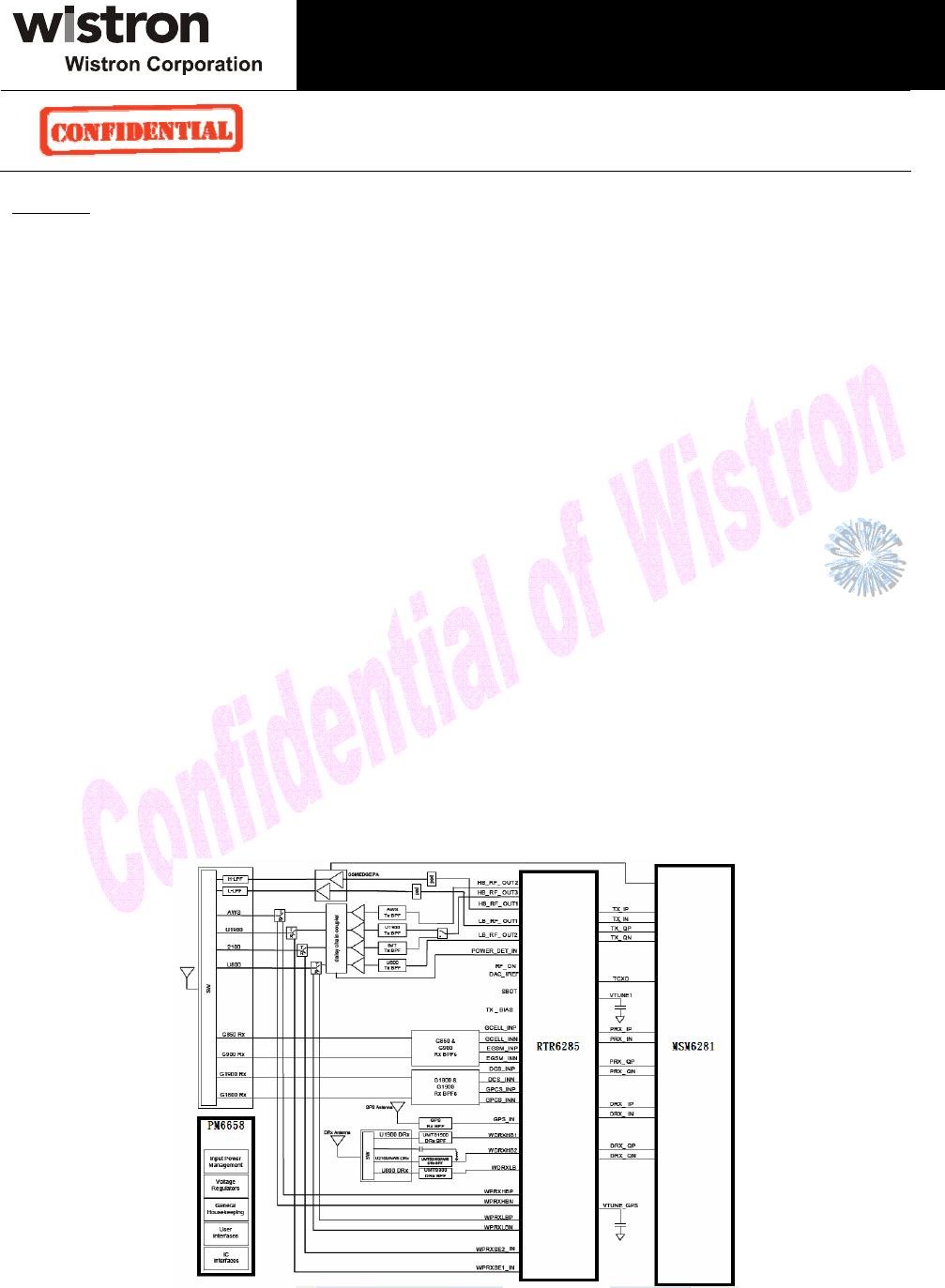
EM300 Data Card Integration Guide
R&D Division, Handheld & Mobile Communication,
Taipei Design Center, Wistron Corp.
Engineering Specification
18
General
The EM300 MODULE are designed to meet the EM300 module electro-mechanical card standard with some
exceptions to accommodate the power requirements. These modules all support only the USB portion of the
minicard standard.
Chipset
The MSM 6281 baseband processor, PM6658 power management IC, RTR 6285 shall be the chipset used for
RF transceiver.
EM300 MODULE
Mobile stations are limited to 2 watts maximum EIRP. The equipment shall employ means to limit the
power to the minimum necessary for successful communication.
The power is supplied to EM300 through the PCI Express Mini Card interface, while VBAT is supplying
voltage to the baseband section. It must be able to provide sufficient current to the power amplifier during the
transmission period.
The analog baseband IC on EM300 has a power management section which controls the voltage
distribution to all functions on the module. The power management section has the following features:
- With low drop linear voltage regulators, the voltages supplied to the GSM baseband can be stabilized.
- During the power-up and power-down procedures, it controls the voltages of the module.
- It provides VREG_MSMP for all external applications. However, in power-down mode, this voltage is not
present.
- It also provides various voltages for the SIM.
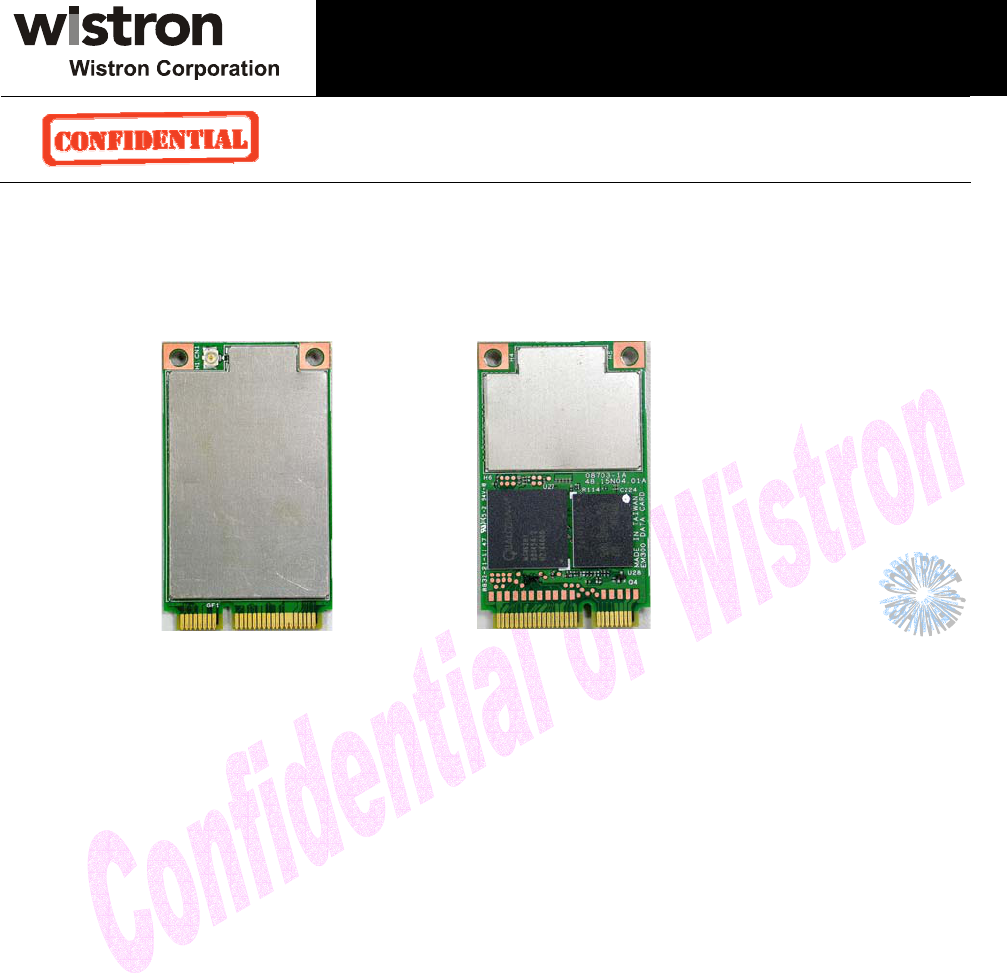
EM300 Data Card Integration Guide
R&D Division, Handheld & Mobile Communication,
Taipei Design Center, Wistron Corp.
Engineering Specification
19
ESTABLISHING COMMUNICATION WITH THE USB CARD AND DETERMINING THE
COMPUTER COM PORT BEING USED
Once the modem is powered up and connected, you should hear a sound indicating the computer has
recognized the modem.
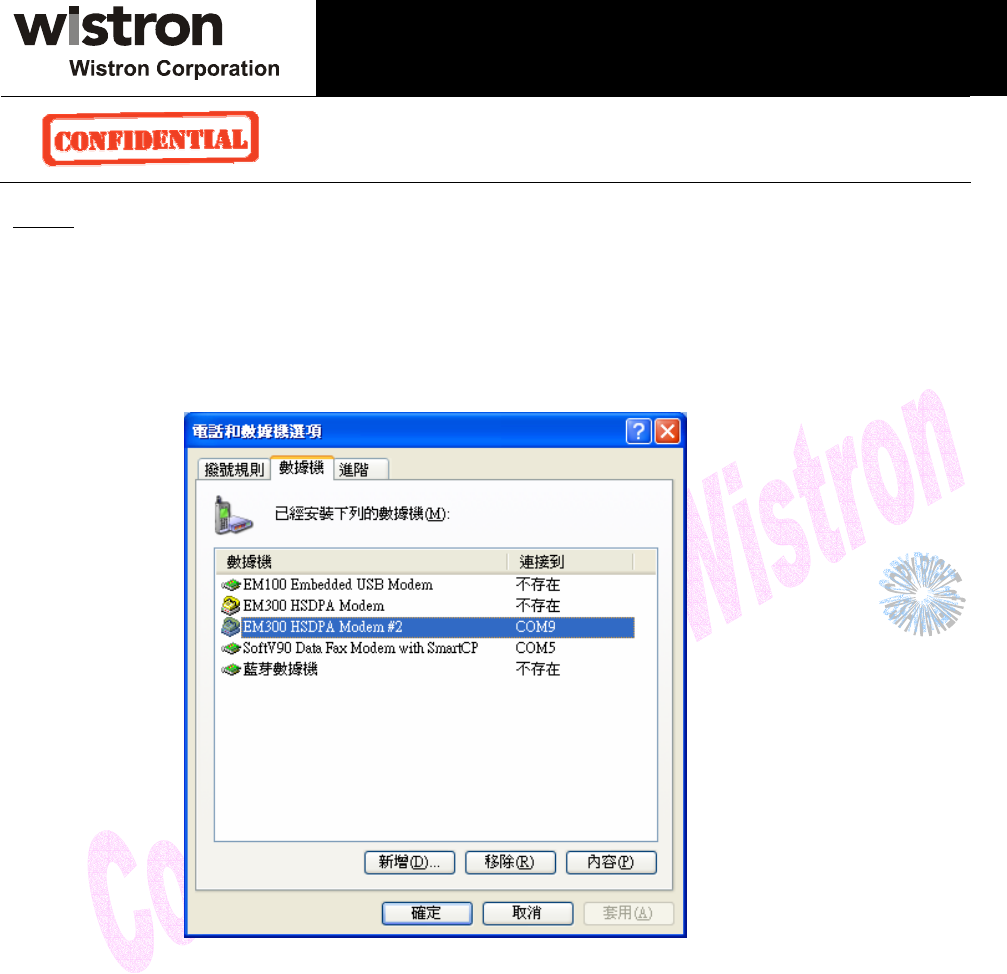
EM300 Data Card Integration Guide
R&D Division, Handheld & Mobile Communication,
Taipei Design Center, Wistron Corp.
Engineering Specification
20
Setup
Determining the Computer’s Active Primary COM Port
To verify the computer’s recognition of the modem and to verify which Primary COM Port it is connected to,
navigate to Start\Control Panel\Phone and Modem Options and then click on the Modems tab within the
Phone and Modem Options window. Refer to Figure 2 below.
Figure 2 – Phone and Modems Options Window
Look for the Wistron CorporationMerlin EM300 MODULE EDGE Modem item on the list. To the right of this
item in the ‘Attached To’ column, you will see a COM port number - make a note of this Primary COM
Port Number. If you do not see any COM No. for this item and you only see “Not Present”, then this indicates
that the modem is not being recognized and is not attached to a COM Port on the
computer. In this case, make sure the USB and power cable are properly connected at both
ends. If the modem has properly booted up, with no SIM in the SIM holder, the WAN LED on the
Development Board should be blinking at a steady rate. If there is a SIM in the SIM Holder, the
LED will be solid green.
Determining the Computer’s Active Secondary or Status COM Port
To verify which Secondary, or Status COM Port the modem is connected to, navigate to Start\Control
Panel\System. After you have double-clicked on the System Icon, click on the Hardware Tab within the
System Properties window. Now click on the Device Manager tab. In the Device Manager window, click on
the “+” beside Modems to expand this item. You should
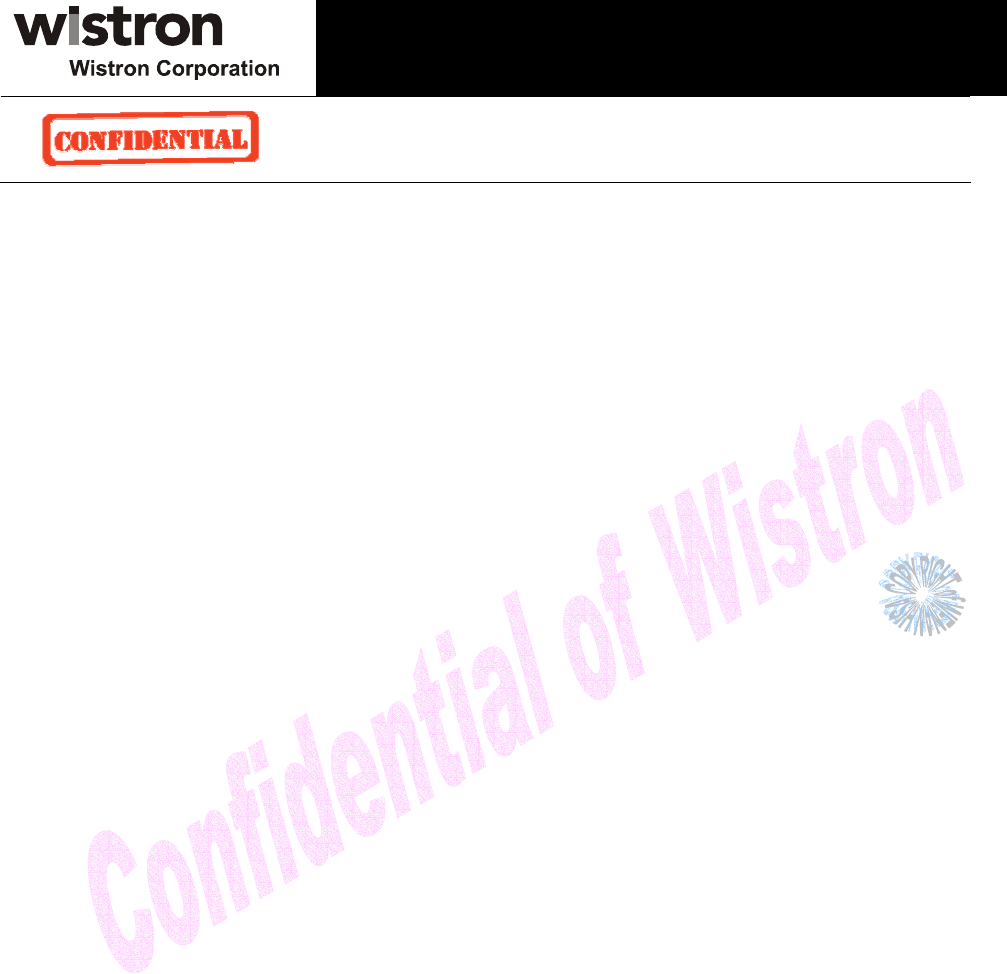
EM300 Data Card Integration Guide
R&D Division, Handheld & Mobile Communication,
Taipei Design Center, Wistron Corp.
Engineering Specification
21
now see the Wistron CorporationExpedite EM300 MODULE EDGE Modem, or something similar listed here.
Refer
to Figure 3 below. Now click on the “+” beside Ports (COM & LPT) to expand this item. You
should now see the Wistron CorporationExpedite EM300 MODULE EDGE Status Port (COM XX) listed here.
This is the Secondary or Status COM port Number. Again, refer to Figure 3 below. Make a note of this
Port Number.
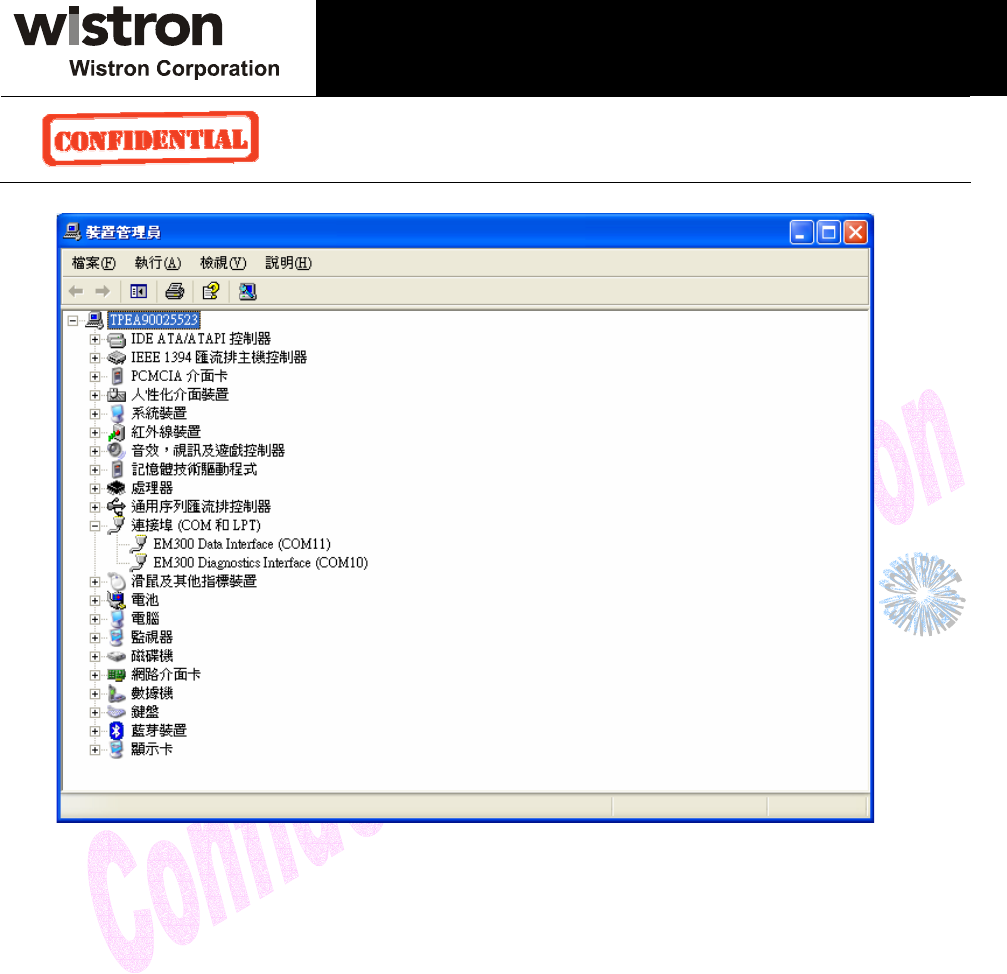
EM300 Data Card Integration Guide
R&D Division, Handheld & Mobile Communication,
Taipei Design Center, Wistron Corp.
Engineering Specification
22
Figure 3 – Device Manager Window Showing the Computer’s Active Status COM Port
SETTING UP HYPERTERMINAL TO COMMUNICATE WITH THE MODEM
Ensure that the Mini-card is still powered on with a USB connection to the computer, and that it is recognized by
the computer as per the previous step.
Open up a HyperTerminal session by navigating to
Start\All Programs\Accessories\Communications\HyperTerminal.
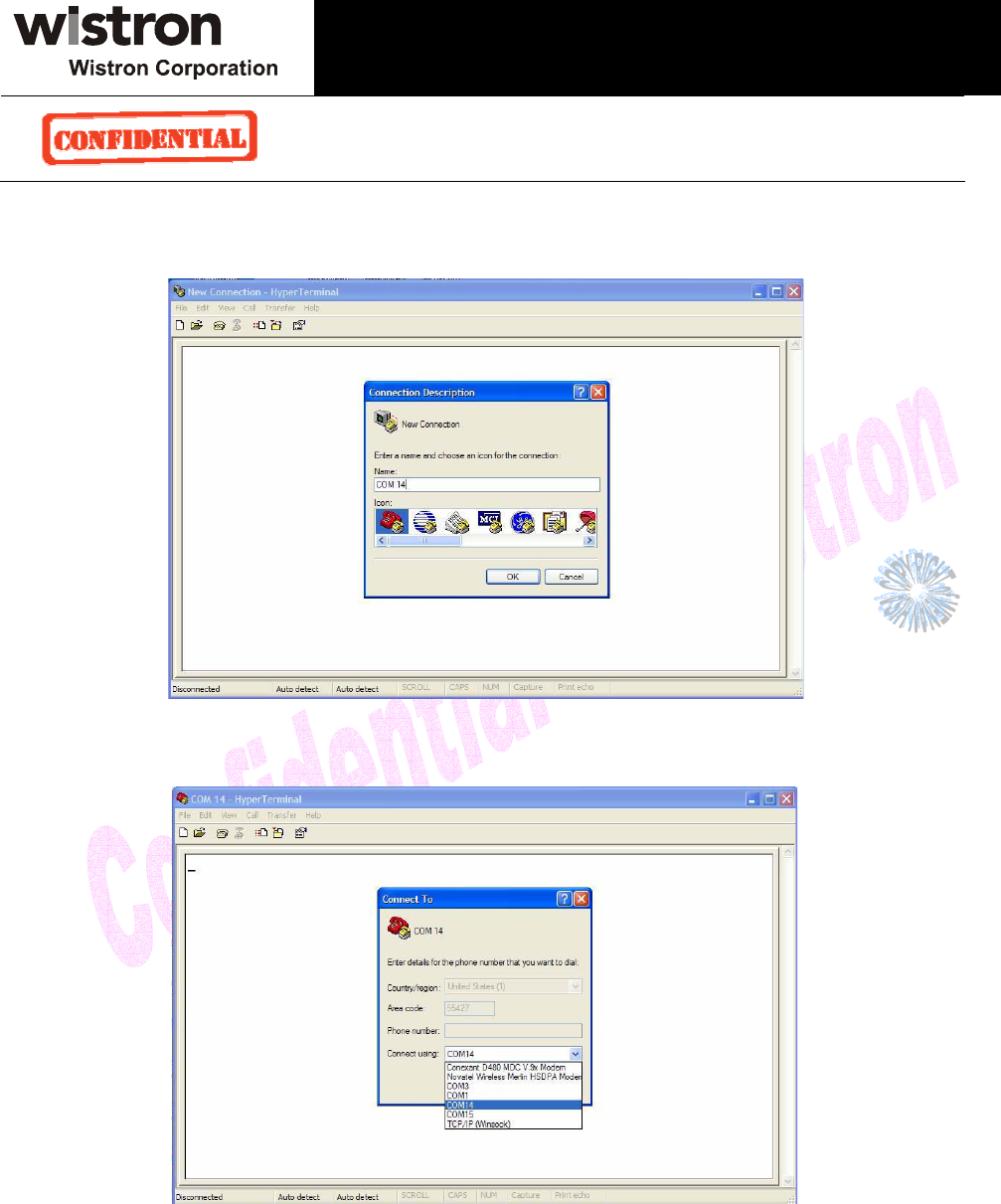
EM300 Data Card Integration Guide
R&D Division, Handheld & Mobile Communication,
Taipei Design Center, Wistron Corp.
Engineering Specification
23
Type in a Connection Description title, such as the Active Primary COM Port number that was
identified earlier - click ‘OK’. See Figure 4 below as an example:
Figure 4 – HyperTerminal Connection Description Window
In the “Connect Using” pull down menu, select the proper COM port (Primary COM port number), that the
computer is using to communicate with the modem, then click ‘OK’. See the example in Figure 5 below:
Figure 5 – HyperTerminal COM Port Selection Window
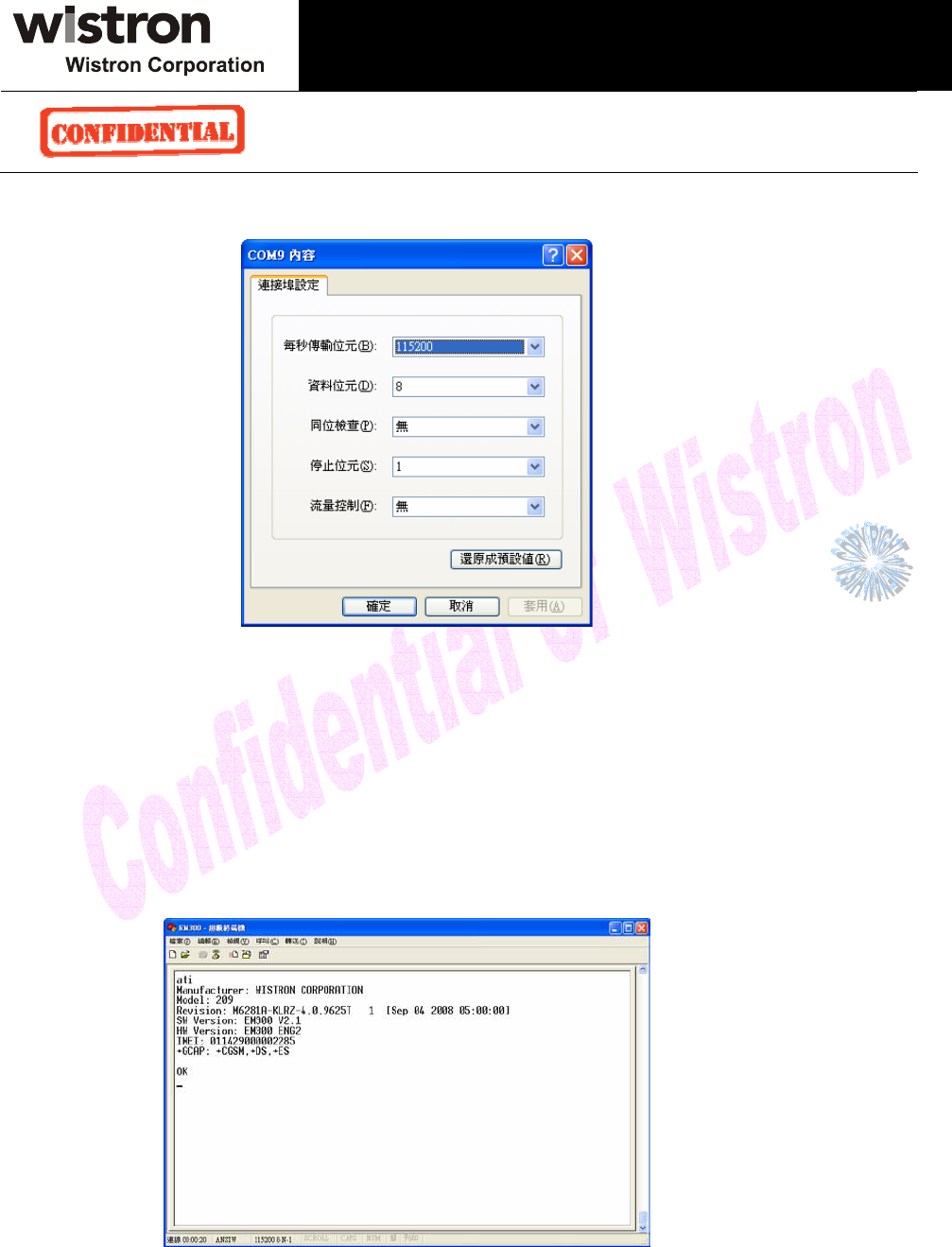
EM300 Data Card Integration Guide
R&D Division, Handheld & Mobile Communication,
Taipei Design Center, Wistron Corp.
Engineering Specification
24
When the ‘COM XX Properties’ window comes up, just click on OK as there is no need to select
or modify any of these settings. Refer to Figure 6 below:
Figure 6 – HyperTerminal Properties Window
Now the modem should be automatically connected, as will be indicated in the bottom left corner
of the HyperTerminal window. To further ensure there is communication to the modem, type “ATI”
and press ENTER. The modem manufacturer, model number, FW revision and IMEI information will
then be returned as is shown in Figure 7 below.
If no information is returned in the HyperTerminal window after typing ATI, then click on the
Disconnect tab at the top of the HyperTerminal window (or click on Call\Disconnect). Reconnect
by clicking on the Connect tab at the top of the HyperTerminal window (or click on Call\Connect). Now
type ATE which will enable the “echo” function of the modem and therefore will allow the characters typed
in the HyperTerminal window to be displayed. Once this has been done, retype the ATI command and
all the modem information should now be displayed in the HyperTerminal window.
Figure 7 – HyperTerminal Communication Window